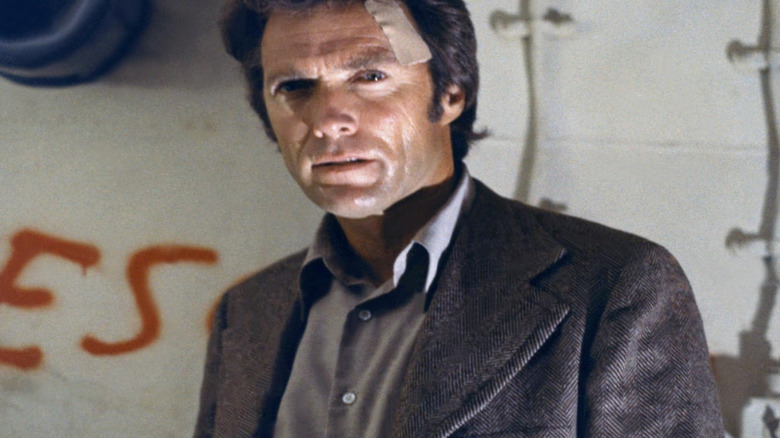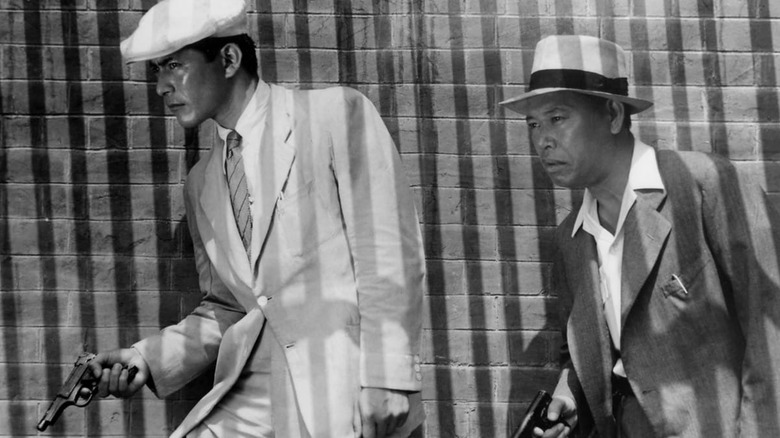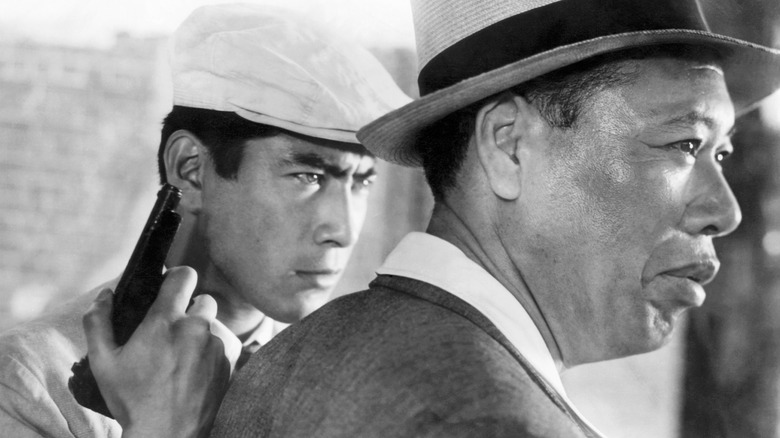Clint Eastwood's Magnum Force Was Inspired By A Genre-Defining Crime Drama
In Ted Post's 1973 cop drama "Magnum Force" — the second movie in the "Dirty Harry" series — Clint Eastwood returns as Harry Callahan, this time paired with a partner, Earlington "Early" Smith, played by Felton Perry. The film follows the two detectives' investigation into a series of extrajudicial murders seemingly being performed by a motorcycle cop. One vigilante killing, they find, is linked to another, and then another. The murders eventually lead them to discover a vast, dark conspiracy within the San Francisco Police Department. It seems that the SFPD is lousy with vigilantes hellbent on frontier justice, and have formed a pact to murder criminals on the street. Harry, disgusted by his own department, will have to find the death ring's leader, and end the violence once and for all.
This was a great way to flip the script on the first "Dirty Harry" movie from 1971. That film was written as a protest of the then-recent Miranda Rights, arguing that cunning killers could easily manipulate the system in their failure, and be released from prison if their rights weren't respected. Callahan ended up having to enact an extrajudicial killing of his own in order to stop the murderous Scorpio (Andrew Robinson). "Magnum Force" sees Callahan trying to stop the cops, who seem to be living out their own "Dirty Harry" fantasies. "Magnum Force" is "Clean Harry."
Moreso, the co-screenwriter of "Magnum Force," John Milius (who shares screenwriting credit with Michael Cimino), felt that his film was derived from Akira Kurosawa's celebrated 1949 noir "Stray Dog." Not so much in story, but in tone. Kurosawa's classic was one of the earliest films to feature a "mismatched cop" pairing, and is famous for its hot and sweaty environs. Back in 1976, Milius spoke with Film Comment Magazine, and revealed that he went to "Stray Dog" for his primary inspiration.
Magnum Force was inspired by Akira Kurosawa's Stray Dog
Kurosawa's "Stray Dog" takes place in the middle of a vicious heat wave in Tokyo. Toshiro Mifune plays a young hotshot detective named Murakami who, as bad luck would have it, has his gun stolen from his pocket while riding a cable car. Losing a gun, as one would assume, is one of the most grievous mistakes a cop can make, so Murakami becomes desperate to track it down. In the parlance of the film, a lost gun in called a stray dog. Murakami tries to infiltrate the world of black market gun dealers, but can't find his own weapon. Evidence begins to appear that a criminal has been using his gun to mug people. Eventually, Murakami's boss pairs him with the laid-back, experienced Detective Sato (Takashi Shimura). This was only the fourth film to star both Mifune and Shimura. They would go on to star in 49 additional films together.
"Stray Dog" is seen by some critics as the start of the "buddy cop" genre, as Murakami is so stern and serious, and Sato is so relaxed. The former is young and single and career-minded, while the latter is a family man who introduces his new partner to his wife and kids. Sato only occupies the middle act of the film, however, as a gunshot removes him from the story. Don't worry. He recovers. "Magnum Force," likewise, isn't centered on the relationship between Callahan and Early, but it does follow the serious-cop/personable-cop team-up format. Milius was clearly trying to replicate that relationship, as well as the mood, of "Stray Dog." In the Film Comment article, he was asked if he was following the traditional patterns of American film noir, to which he replied plainly "No, I wanted it to be like 'Stray Dog'; I was thinking in terms of Kurosawa's detective flicks."
There it is.
The cycle of inspiration
Milius also confessed in that same interview that his original scripts do contain some salacious B.S. that he openly takes the blame for. He mentioned a scene at the end of "Dirty Harry" where Scorpio was holding a flamethrower on a bus full of kids. The flamethrower was removed from the final version. "In my script version," he said, "there's just more outrageous Milius crap." He also admitted that he kind of hated "Magnum Force," saying:
"I don't like 'Magnum Force.' Of all the films I had anything to do with, I like it least. They changed a lot of things in a cheap and distasteful manner. The whole ending is wrong, it wasn't mine at all."
And while "Magnum Force" may have started as a riff on "Stray Dog," it turned into more of an action film at the end. Milius said that his version of the script didn't feature nearly as much on-screen violence, a feature also attributable to Akira Kurosawa.
Kurosawa, meanwhile, has said many times that he took his inspiration for "Stray Dog" from Jules "Rififi" Dassin's 1948 police procedural "The Naked City," and that he borrowed a lot of his ideas from the works of Belgian detective novelist George Simenon, so "Magnum Force" was merely part of a long cycle of inspiration. Some fun trivia: the montage scenes of Mifune trekking silently around Tokyo's criminal underworld were filmed by Ishiro Honda, a longtime collaborator and friend of Kurosawa's who would go on to direct multiple "Godzilla" movies. Honda and Kurosawa would walk their respective career paths until the 1980s, when they reunited to work on films like "Kagemusha," "Ran," and "Dreams" together.
Jules Dassin, Akira Kurosawa, Dirty Harry, and Godzilla are all swimming in the same pool.


